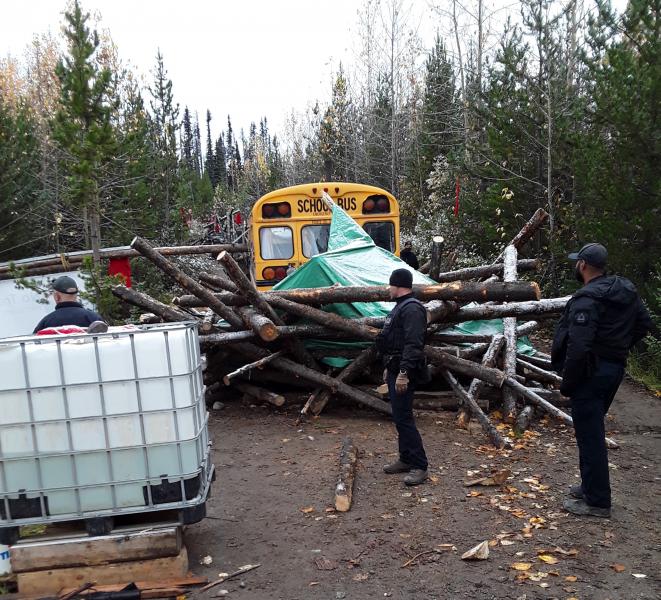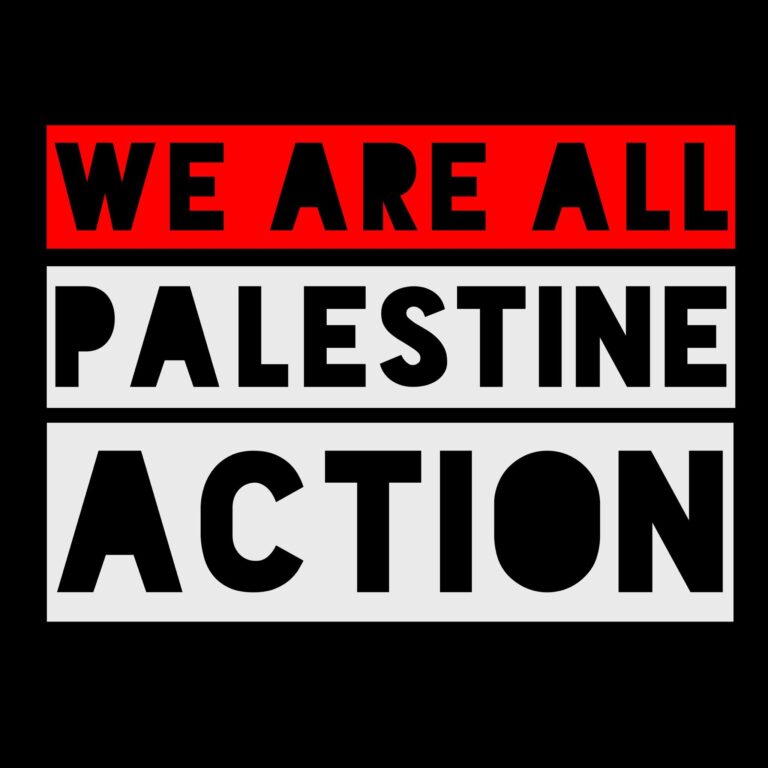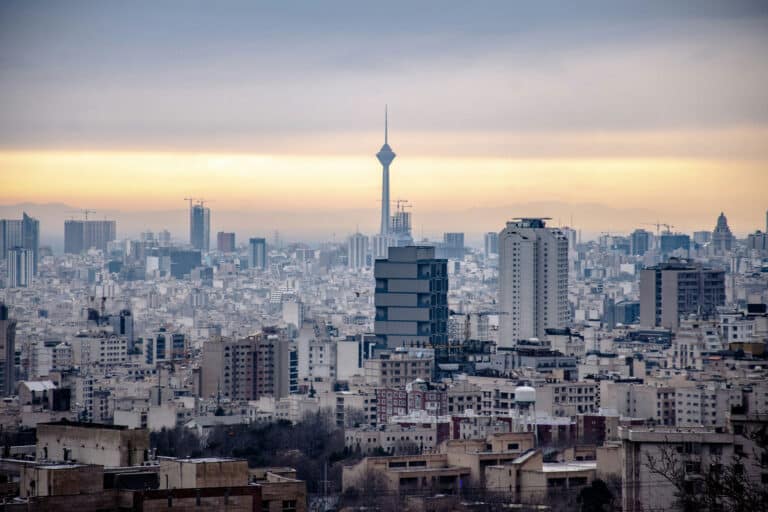The view from Coyote Camp took my breath away every time. Snowcapped mountains filled the horizon, reflecting the rosy glow of dawn and the bright midday sun. Far below, a band of trees concealed the pristine river that the Wet’suwet’en call Wedzin Kwa. Between river and peaks rolled dense, damp forest. Walking into camp one day, I called to a visiting Wet’suwet’en elder gazing out over the slope, “Enjoying the view?” “Not so much,” he replied gravely, and I winced at my misstep. While my eyes were drawn upward to the mountains, his were drawn downward to the fresh scar across the landscape. The Coastal GasLink (CGL) pipeline right-of-way cuts across the river valley, rising from one ridge of mountains to the next. Where it approaches the river, CGL has cleared a patch of land several hundred metres wide, scraping away trees, moss, fungi, small plants and even rocks, leaving only an expanse of boot-sucking mud. This drill pad was meant to be CGL’s base to bring in machinery and begin tunnelling under the river. Wet’suwet’en land defenders and water protectors decided that would not be allowed to happen, and Coyote Camp came into being.
Arriving on 3 October, I was amazed to see what had come together in the first week of Gidimt’en Checkpoint’s frontline camp existence. Numerous creative roadblocks kept CGL machinery and police cars out. A large cistern held drinking water drawn from the Wedzin Kwa. A portable tiny house backed a lean-to kitchen, and winterized tents housed supporters of the Wet’suwet’en land struggle. Right in the middle of the drill pad stood a small log cabin built that very day.
This reoccupation of Wet’suwet’en land—the yintah—is the most recent chapter in a long campaign of resistance and reclamation. In 1997, a landmark decision by Canada’s Supreme Court on the Delgamuukw/Gisday’wa case affirmed that the Wet’suwet’en people, represented by their hereditary leaders, had never given up their rights and title to 22,000 square kilometres of land in so-called northern British Columbia. Despite this and subsequent rulings, government and corporations have yet to acknowledge any definition of Indigenous sovereignty that includes the right to say no to resource extraction projects. For the past twelve years, Unist’ot’en Camp has stood in the path of an “energy corridor” envisioned by industry as a route for multiple oil and gas pipelines connecting the Alberta tar sands and fracking operations in northeastern British Columbia to the Pacific port of Kitimat. More recently, Gidimt’en Checkpoint was established to assert Wet’suwet’en sovereignty and support pipeline resistance. The Wet’suwet’en hereditary chiefs and matriarchs who lead the camps, along with Indigenous and settler allies who support them, have endured persistent industry and police harassment, two militarized police raids, dozens of arrests and multiple instances of police brutality.
Our team of CPT reservists arrived at a time of high tension. The establishment of Coyote Camp was met with brutal attacks by the Royal Canadian Mounted Police (RCMP). Before our arrival, RCMP officers had tasered one camp supporter. Police also spent several hours physically and psychologically torturing a supporter locked under a bus blocking the road. During the first week we were there, officers of the RCMP’s Community-Industry Response Group (CIRG)—an “elite” task force established specifically to suppress resistance to industrial resource extraction in British Columbia—walked through Coyote Camp nearly every day in defiance of an eviction order from Wet’suwet’en hereditary chiefs. CIRG officers shoved past camp security volunteers who asked them to leave and proceeded to inspect and photograph vehicles, buildings, tents and other installations. CPTers heard police joking about genocide and saying they couldn’t wait to see themselves on social media. One officer, Sgt. Jason Charney, took obvious pleasure in taunting and trying to provoke legal observers and media. On 10 October, Charney emptied the camp’s drinking water cisterns and threatened to arrest a CPT member who sought to intervene. Police also rifled through tents and stole keys to a vehicle.

Despite the climate of anxiety, our time at camp was also a time of excitement, joy and cooperation. New camp supporters arrived often, bringing energy, passion, and a variety of skills. Indigenous and settler allies from across Turtle Island worked together to build up and maintain both Coyote Camp and the original Gidimt’en Checkpoint camp down the road. According to our strengths and skills, we cooked, washed dishes, cleaned and organized facilities, watched road traffic, hiked supplies across roadblocks, carried water, cut firewood, provided medical care, built new kitchens and outhouses, and constructed elaborate art installations. We sang and talked around the campfire, laughed a lot, and learned from each other. The kindness and generosity I experienced among people under intense stress did a great deal to soften the memories of police cruelty.
A turning point came when a group of Haudenosaunee (Six Nations) Land Defenders visited in response to Gidimt’en Checkpoint’s call for support. As RCMP officers walked towards camp, the Haudenosaunee allies spread out across the road. Shilo, an Onondaga Land Defender who is Chief Woos’ son-in-law, bellowed, “You are on Chief Woos’ territory! You come as invaders! Leave!” The police turned and retreated, with the Haudenosaunee and other allies following them down the road. For the remaining two weeks of our stay, there were no more police incursions into Coyote Camp.
Of course, the story doesn’t end there. In late October, days before we left, another site of struggle emerged. Likhts’amisyu Clan Chiefs from a nearby Wet’suwet’en community notified CGL that construction machines must either be removed from their territory or they will be decommissioned. When CGL failed to respond, the Chiefs took possession of the machinery and removed their batteries. CGL blocked the road, preventing Chief Tsebesa from accessing her territory, and the Chiefs and their supporters set up camp on the road to wait to be allowed to pass. Chief Dsta’hyl, Colin Sutherland-Wilson and another Land Defender were arrested and held overnight. In solidarity, Haudenosaunee Land Defenders from 1492 Land Back Lane blockaded a highway bypass in southern Ontario for several days. Nothing has been resolved, and people at Gidimt’en Checkpoint are preparing both camps for a long winter.
For now, the Wedzin Kwa runs clear. Its waters are safe to drink and support recovering populations of sockeye, Chinook and Coho salmon. Grizzly bears and black bears fish from its banks, as do the Wet’suwet’en people, who have called themselves “Salmon Nation.” Canada has a clear choice: to respect Indigenous sovereignty and the life of the yintah, or to continue using state force to tear apart the land to get oil and gas flowing to tankers on the coast.
Please follow Wet’suwet’en Land Defenders!
Web:
Yintahaccess.com
Unistoten.camp
likhtsamisyu.com
Facebook:
Gidimt’en Checkpoint
Wet’suwet’en Camp
Sovereign Likhts’amisyu
Instagram:
Yintah_access
Unistoten.camp
sovereignlikhtsamisyu
Twitter:
Gidimt’en Checkpoint
Unist’ot’en Camp
Likhts’amisyu (Fireweed) Clan




